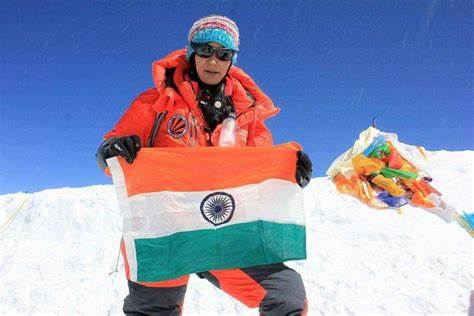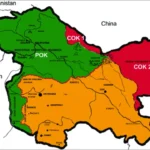Chhonzin Angmo Becomes the First Totally Blind Indian Woman to Conquer the World’s Tallest Peak
In a historic and awe-inspiring achievement, Chhonzin Angmo, a 31-year-old visually impaired mountaineer from Himachal Pradesh, has become the first Indian woman with total blindness to successfully summit Mount Everest. This extraordinary feat has not only earned her a place in mountaineering history but also served as a powerful symbol of courage, determination, and the limitless potential of the human spirit.
Breaking Barriers on the Roof of the World
Mount Everest, standing at 8,848.86 meters above sea level, is widely considered one of the most difficult and dangerous climbs on Earth. For someone with no vision, the challenges multiply — from navigating treacherous terrain to surviving extreme weather conditions.
Despite these obstacles, Chhonzin Angmo reached the summit on May 20, 2025, guided by a trained team of Sherpas and aided by modern climbing technology. Her triumphant climb is being recognized as a landmark moment in the history of Indian mountaineering.
Early Life and the Journey to Everest
Hailing from the Lahaul and Spiti region of Himachal Pradesh, Chhonzin experienced complete vision loss early in life because of a hereditary condition. Yet, she refused to let her impairment limit her potential. A graduate in Psychology and a passionate advocate for disability rights, Chhonzin has been actively involved in outdoor activities, particularly trekking and climbing, since her college days.
Her dream to conquer Mount Everest began nearly five years ago. She underwent rigorous training, including altitude simulation, endurance building, and practicing with adaptive climbing equipment. She trained in the Himalayas and the Western Ghats, scaling several 5,000 and 6,000-meter peaks to prepare herself physically and mentally.
Scaling Everest: A Test of Endurance and Spirit
Angmo’s expedition began in early April 2025. Accompanied by a team of highly skilled Sherpas and supported by a small group of climbers and medical personnel, she reached Everest Base Camp in mid-April. The climb involved several acclimatization rotations between the camps before making the final push.
Despite extreme cold, low oxygen, and steep ice walls, Angmo maintained her composure and focus throughout the expedition. She relied on tactile signals, voice commands from her guide, and adaptive trekking poles to navigate.
At 6:10 AM on May 20, 2025, she stood on the summit of Mount Everest — raising the Indian flag and breaking boundaries for the visually impaired community across the world.
National Recognition and Public Response
Chhonzin’s incredible journey has captured the nation’s imagination. Social media platforms erupted with congratulatory messages. Leading personalities such as Prime Minister Narendra Modi, President Droupadi Murmu, along with numerous celebrities and sportspersons, applauded her for pushing boundaries and redefining what can be achieved.
The Ministry of Youth Affairs and Sports has announced a special commendation, and the Indian Mountaineering Foundation (IMF) has nominated her for the prestigious Tenzing Norgay National Adventure Award.
Empowering the Differently Abled: A New Era
Angmo’s summit is more than a personal victory — it’s a beacon of hope for millions of differently abled individuals in India and beyond. Her mission, she says, is not just to conquer mountains but to break stereotypes and encourage inclusivity in outdoor sports.
In her own words:
“Disability is not inability. If the mountains don’t discriminate, why should society?”
She now plans to launch a non-profit initiative called “Beyond the Summit”, aimed at training and empowering people with disabilities in adventure sports and outdoor education.
Global Media Coverage
Chhonzin’s success has also made international headlines. Publications such as The Guardian, BBC, and National Geographic have covered her story, highlighting the technological innovations that made the climb possible and the growing global focus on inclusivity in extreme sports.
The Role of Technology and Teamwork
Advanced GPS tracking, satellite communications, tactile feedback devices, and verbal navigation systems played a key role in Angmo’s success. Her Sherpa team, trained specifically in guiding visually impaired climbers, ensured safety and precision throughout the expedition.
What’s Next for Chhonzin Angmo?
Following her Everest conquest, Angmo has announced her goal of completing the Seven Summits Challenge — climbing the highest peaks on each continent. Her next target is Mount Kilimanjaro in Africa, followed by Mount Elbrus in Russia.
She also plans to author an autobiography and begin motivational speaking to encourage youth and people with disabilities to dream big and pursue adventure fearlessly.
Conclusion: An Unforgettable Moment in Indian Sports History
Chhonzin Angmo’s ascent of Mount Everest in 2025 is a milestone not just in Indian sports but in the broader narrative of inclusion, resilience, and female empowerment. Her journey serves as a reminder that determination knows no limits — and that even the highest peaks can be conquered with courage and conviction.
As the world celebrates her achievement, Angmo continues to inspire countless others to look beyond limitations and reach for their own summits.





